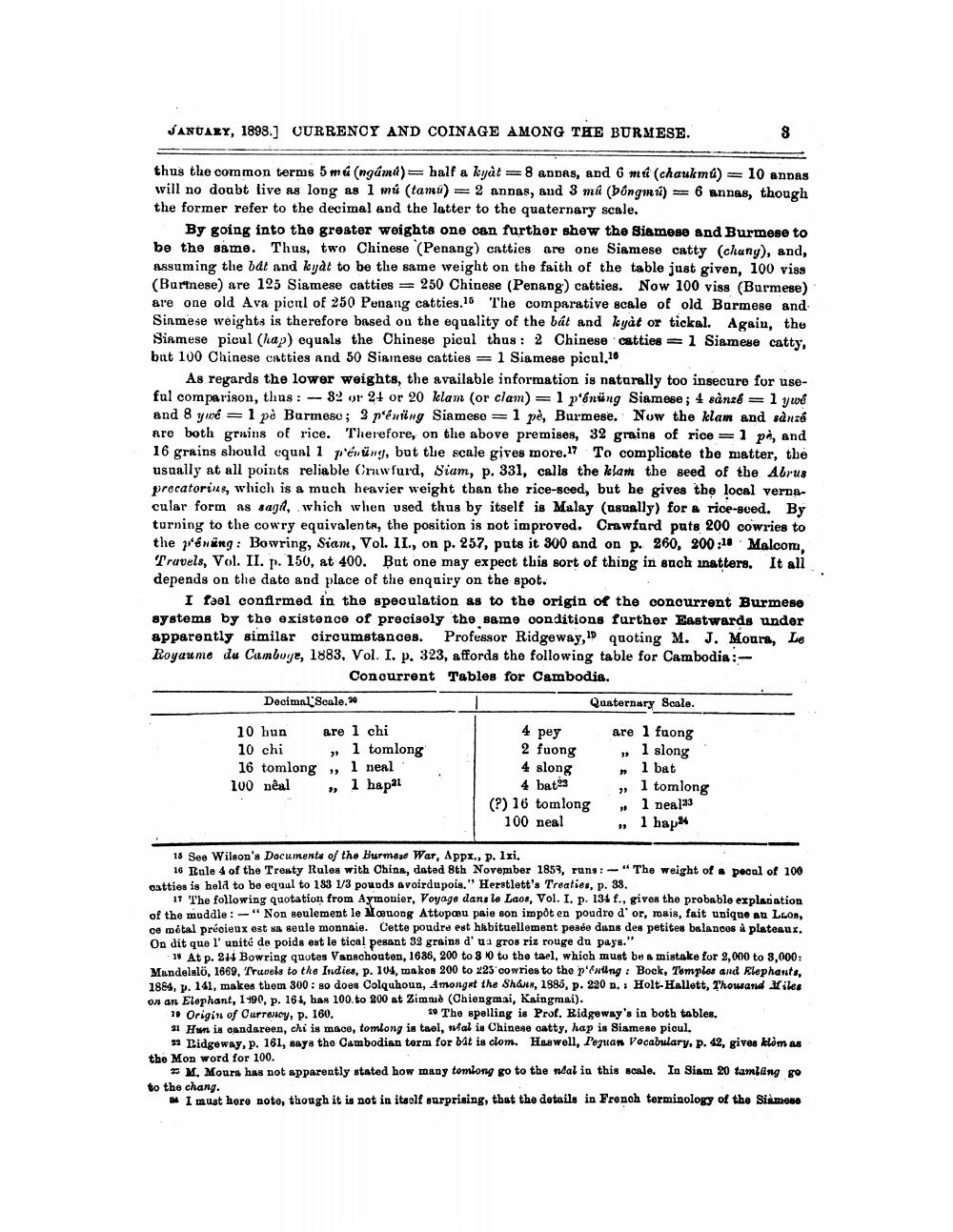Book Title: Indian Antiquary Vol 27 Author(s): Richard Carnac Temple Publisher: Swati Publications View full book textPage 7
________________ JANUARY, 1898.] CURRENCY AND COINAGE AMONG THE BURMESE. thus the common terms 5 ma (ngám) = half a kyàt=8 appas, and 6 mei (chaukmu) = 10 anpas will no doubt live as long as I mů (tamu) = 2 andas, and 3 må (bongmu) = 6 annas, though the former refer to the decimal and the latter to the quaternary scale. By going into the greater weights one can further show the Siamese and Burmese to be the same. Thus, two Chinese (Penang) catties are one Siamese catty (chany), and, assuming the bat and kyat to be the same weight on the faith of the table just given, 100 viss (Bartese) are 125 Siamese catties = 250 Chinese (Penang) catties. Now 100 viss (Burmese) are one old Ava picnl of 250 Penang catties.15 The comparative scale of old Burmese and Sinmese weights is therefore based on the equality of the bát and keyàt or tickal. Again, the Siamese picul (hap) equals the Chinese picul thus: 2 Chinese catties = 1 Siamese catty, but 100 Chinese catties and 50 Siamese catties = 1 Siamese picul.16 As regards the lower weights, the available information is naturally too insecure for useful comparison, thus: -- 32 or 2+ or 20 klam (or clam) = 1 pénüng Siamese; 4 sànze = 1 ywe and 8 ywe = 1 pe Burmeso; 3 préuting Siamese = 1 pè, Burmese. Now the klam and sàng are both grains of rice. Therefore, on the above premises, 32 grains of rice=l pà, and 16 grains should equal 1 pening, but the scale gives more.17 To complicate the matter, the usually at all points reliable Crawfurd, Siam, p. 331, calls the klare the seed of the Abrus precatorins, which is a much heavier weight than the rice-sced, but he gives the local vernacular form as sagat, which when used thus by itself is Malay (asually) for & rice-seed. By turning to the cowry equivalents, the position is not improved. Crawfurd pats 200 cowries to the pening: Bowring, Sian, Vol. II., on p. 257, puts it 300 and on p. 260, 200:18 Malcom, Travels, Vol. II. p. 150, at 400. But one may expect this sort of thing in such inatters. It all depends on the date and place of the enquiry on the spot. I faol confirmed in the speculation as to the origin of the concurrent Burmese systems by the existence of precisely the same conditions further Eastwards under apparently similar circumstances. Professor Ridgeway, quoting M. J. Moura, Le Royaume du Camboye, 1883, Vol. I. p. 323, affords the following table for Cambodia : Concurrent Tables for Cambodia. Decimal'Scale. Quaternary Scale. 10 hun are 1 chi are 1 fuong 10 chi 1 tomlong 2 fuong » 1 slong 16 tomlong. I neal 4 slong 1 bat 100 nêal » 1 hapal 4 bat23 1 tomlong (?) 16 tomlong 1 nea123 100 neal „ 1 hapa 4 pey 15 See Wilson's Documents of the Burmese War, Appr., p. lxi. 10 Rule 4 of the Treaty Rules with China, dated 8th November 1859, runs: "The weight of specul of 100 oatties is held to be equal to 183 1/3 pounds avoirdupois." Herstlett's Treaties, p. 38. 11 The following quotation from Aymonier, Voyage dans le Laos, Vol. I. p. 134 1., given the probable explanation of the muddle: "Non seulement le M uong Attopou paie son impot en poudre d'or, mais, fait unique au LLO, ce métal précieux est sa seule monnaie. Cette poudre est habituellement pesée dans des petitea balancos à plateaux. On dit que l'unité de poids est le tical pesant 32 grains d'ua gros ris rouge du pays." 1 At p. 214 Bowring quotes Vanschouten, 1686, 200 to 80 to the tael, which must be mistake for 2,000 to 8,000: Mandelslö, 1869, Trusela to the Indies, p. 104, makon 200 to 225'cowries to the p'enting : Bock, Tomples and Elephants, 1884, p. 141, makes them 300 : 80 does Colquhoun, Amongst the Shann, 1986, p. 220 . Holt-Hallett, Thowanid Miles on an Elophant, 1990, p. 164, has 100. to 200 at Zimnd (Chiengmai, Kaingmai). 19 Origin of Currency, p. 160. 10 The spelling is Prof. Ridgeway's in both tables. 21 Hwn is gandareen, chi is maco, tomlong is tael, wal is Chinese catty, hap is Siamese picul. 21 Lidgeway, p. 161, says the Cambodian torm for bit is clom. Howell, l'eguan Vocabulary, p. 42, gives klóm as the Mon word for 100. M. Moura has not apparently stated how many tomlong go to the ndal in this scale. In Siam 20 tamling go to the chang. I must here note, though it is not in itself surprising, that the details in French terminology of the SiamesePage Navigation
1 ... 5 6 7 8 9 10 11 12 13 14 15 16 17 18 19 20 21 22 23 24 25 26 27 28 29 30 31 32 33 34 35 36 37 38 39 40 41 42 43 44 45 46 47 48 49 50 51 52 53 54 55 56 57 58 59 60 61 62 63 64 65 66 67 68 69 70 71 72 ... 404
